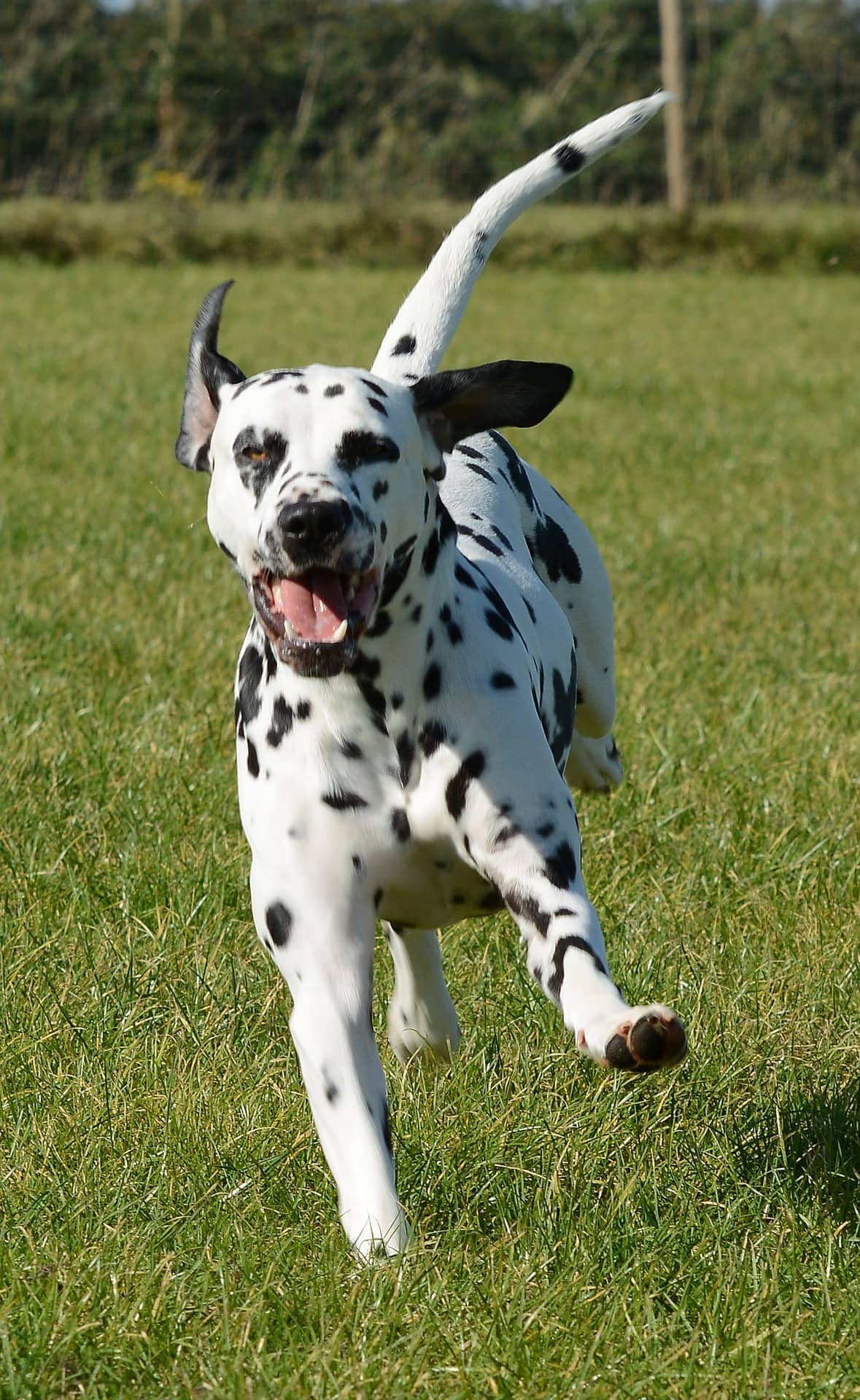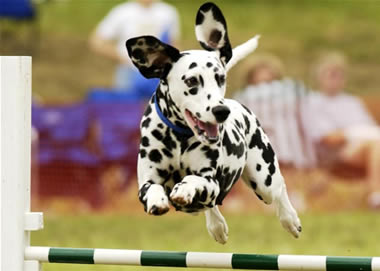With their iconic spots and striking appearance, Dalmatians have captured the hearts of many. But did you know that behind their charming exterior lies a breed known for being notoriously difficult to train? Yes, these beautiful dogs can present quite a challenge when it comes to obedience and behavior.
Dalmatians have a stubborn streak that can make training them a bit of a challenge. This is partly due to their independent nature and their innate desire to do things their own way. Additionally, their history as carriage dogs and firehouse mascots has also played a role in shaping their temperament. While Dalmatians are intelligent and quick learners, their strong-willed nature and high energy levels can sometimes make training sessions a test of patience. However, with consistent positive reinforcement techniques and engaging activities, such as agility courses or puzzles, Dalmatians can thrive and become well-behaved companions. So, while training a Dalmatian may require some extra effort, the rewards of having a well-behaved and loyal companion make the journey worthwhile.
Training Dalmatians requires patience and consistency. Start with basic obedience commands like sit, stay, and come. Use positive reinforcement techniques such as treats and praise. Gradually introduce more advanced commands like heel and down. Focus on socialization to prevent any aggression issues. Dedicate regular training sessions and make it fun with interactive toys and games. Remember, each Dalmatian is unique, so adapt the training methods accordingly. With time and effort, you’ll have a well-trained, obedient Dalmatian companion.

How Hard Are Dalmatians to Train? Exploring the Challenges and Rewards
Dalmatians are known for their unique spotted coat, playful personality, and association with fire stations. But how hard are they to train? In this article, we delve into the world of Dalmatian training to understand the challenges and rewards that come with it. Whether you’re considering owning a Dalmatian or already have one, this guide will provide valuable insights on the training process. So, let’s jump right in!
The Dalmatian Training Process: A Closer Look
Training a Dalmatian requires time, patience, and consistency. Here are three key aspects to consider when embarking on the training journey with your Dalmatian:
1. Intelligence and Independence:
Dalmatians are known for their intelligence, which makes them quick learners. However, their independent nature can pose challenges during training. They are not always eager to please their owners like some other breeds. Dalmatians may have a stubborn streak, making them prone to testing boundaries. Therefore, it’s essential to establish yourself as the leader through consistent training methods and positive reinforcement.
One strategy to enhance the training process is to make it mentally stimulating. Dalmatians thrive when engaged in activities that challenge their minds. Incorporate puzzle toys, obedience exercises, and interactive games into their routine to keep them mentally stimulated and focused.
2. Socialization and Puppy Training:
Socialization is crucial for Dalmatians as it helps them develop into well-rounded and confident dogs. Early socialization should begin from puppyhood to expose them to various people, animals, environments, and situations. This process helps prevent the development of fear-based behavior and aggression.
Puppy training classes are highly recommended for Dalmatians. These classes provide an opportunity for your pup to interact with other dogs and learn basic commands. It also allows you to bond with your Dalmatian while receiving guidance from professional trainers.
3. Exercise and Mental Stimulation:
Dalmatians are an energetic breed that requires regular exercise to stay physically and mentally fulfilled. Boredom and pent-up energy may lead to destructive behavior such as excessive barking or chewing. Therefore, incorporating daily exercise routines like long walks, runs, or play sessions in a securely fenced area is crucial.
Mental stimulation is equally important for Dalmatians. Agility training, scent work, and obedience training are great ways to challenge their intellect. These activities keep their minds engaged while reinforcing training commands.
Training Tools and Techniques for Dalmatians
Now that we have explored the key aspects of Dalmatian training, let’s dive into some essential tools and techniques that can enhance the training process:
1. Positive Reinforcement:
Dalmatians respond well to positive reinforcement techniques such as rewards-based training. Use treats, praise, and affection to reward your Dalmatian for desired behavior. Consistency and patience are key when employing positive reinforcement, as it encourages them to repeat the behavior you want to reinforce.
2. Clicker Training:
Clicker training is a popular technique for many dog breeds, including Dalmatians. It involves using a small handheld device that makes a distinct clicking sound. The clicker is associated with rewards and helps mark desired behaviors as they occur, making it easier for your Dalmatian to understand what you expect from them.
3. Crate Training:
Crate training is beneficial for Dalmatians, especially during puppyhood. It provides them with a safe and comfortable space while also aiding in house-training and preventing destructive behavior when unsupervised. Introduce the crate gradually, making it a positive and inviting space with their bed, toys, and treats.
Training Challenges and Tips for Success
Although Dalmatians are intelligent and trainable, certain challenges may arise during the training process. Here are a few common challenges and tips for overcoming them:
1. Stubbornness:
As mentioned earlier, Dalmatians can be stubborn at times. It’s important to approach training with patience and consistency. Breaking down commands into smaller, manageable steps can help them understand and execute tasks more easily. Celebrate small victories and reward progress to motivate your Dalmatian.
2. Attention Span:
Dalmatians, like any other breed, have varying attention spans. Keeping training sessions short and engaging helps maintain their focus. Aim for 10-15 minute sessions multiple times a day rather than one long session. This allows your Dalmatian to absorb information without getting overwhelmed.
3. Separation Anxiety:
Dalmatians can be prone to separation anxiety if not properly trained. Gradual desensitization to your departures, combined with crate training and providing interactive toys or puzzles, can help alleviate separation anxiety. Establish a routine that includes daily exercise before leaving them alone to help reduce their anxiety levels.
Final Advice: Patience and Perseverance Pay Off
Training a Dalmatian requires dedication, patience, and a positive mindset. Remember that every dog is unique, and the training process may vary from one individual to another. Celebrate small victories, stay consistent with training methods, and seek professional guidance if needed. With time and effort, you can develop a strong bond and a well-behaved Dalmatian companion who brings joy and happiness to your life. So, embrace the training journey and enjoy the rewards that come with it!
Key Takeaways: How Hard Are Dalmatians to Train?
Training Dalmatians can be challenging, but with patience and consistency, it is possible to train them effectively.
Here are 5 key takeaways:
- Dalmatians are known to have an independent and stubborn nature.
- Early socialization and obedience training are crucial for Dalmatians.
- Positive reinforcement techniques work best when training Dalmatians.
- Consistency and repetition in training sessions will yield better results.
- Exercises and mental stimulation are essential to prevent boredom in Dalmatians.
Frequently Asked Questions
When it comes to training Dalmatians, many potential owners have questions about the level of difficulty. Below, we provide answers to some commonly asked questions about training Dalmatians.
Are Dalmatians difficult to train?
Training Dalmatians can be challenging, but it’s not impossible. Dalmatians are known for being independent thinkers, which means they may not always follow commands without question. This can make training sessions longer and require extra patience and consistency. However, with the right approach and positive reinforcement, Dalmatians can learn and become well-behaved companions.
Proper socialization and early training are key for Dalmatians. Consistency in routines, positive reinforcement techniques, and using reward-based methods can help establish a strong bond with your Dalmatian and make the training process easier. It’s also essential to create a structured environment with clear rules and boundaries to guide their behavior.
How long does it take to train a Dalmatian?
The time it takes to train a Dalmatian can vary depending on various factors such as the individual dog’s personality, previous training experiences, and consistency in training methods. Some Dalmatians may catch on quickly and respond well to training, while others may take longer to grasp commands consistently.
On average, it may take several weeks to a few months of consistent training sessions to see noticeable progress and have a well-trained Dalmatian. The key is to remain patient, consistent, and positive during the training process. Regular practice and repetition of commands in different environments can help solidify their training and ensure they respond reliably in various situations.
What are some tips for training a Dalmatian?
When training a Dalmatian, here are some tips to keep in mind:
1. Start training early: Begin training your Dalmatian as soon as you bring them home to establish good habits from the start.
2. Be consistent: Use consistent commands and training methods to avoid confusion and reinforce desirable behavior.
3. Use positive reinforcement: Reward your Dalmatian with treats, praise, or play for following commands correctly, encouraging them to repeat the behavior.
4. Socialize your Dalmatian: Expose them to various environments, people, and other animals to help them become well-rounded and confident.
5. Be patient: Training a Dalmatian requires patience and understanding. Avoid punishments or harsh training techniques, as these can be counterproductive and lead to fear or aggression.
Can I train a Dalmatian by myself, or do I need professional help?
You can certainly train a Dalmatian by yourself, but professional help can be beneficial, especially if you’re a first-time dog owner or struggling with specific training challenges. A professional trainer can provide guidance, offer effective training techniques, and address any behavior issues you may encounter.
If you decide to hire a professional trainer, choose someone experienced with Dalmatians or working with similar high-energy breeds. They can assess your Dalmatian’s temperament, create a tailored training plan, and provide hands-on training sessions and ongoing support.
However, with dedication, research, and following proven training methods, you can train a Dalmatian successfully on your own. It’s essential to educate yourself about their breed-specific traits, proper training techniques, and be committed to consistent training sessions to achieve desired results.
Are Dalmatians suitable for first-time dog owners?
While Dalmatians can be loving and loyal pets, they may not be the best choice for first-time dog owners due to their unique characteristics and potential training challenges. Dalmatians are known for their energy, intelligence, and independent nature.
They require an owner who can provide consistent and firm leadership, along with an understanding of their exercise needs and mental stimulation requirements. First-time owners may find it more manageable to start with a breed that is more forgiving when it comes to training or has a more predictable temperament.
If you are a first-time dog owner and are set on having a Dalmatian, it’s crucial to educate yourself about their specific needs, invest time in training and socializing them from an early age, and be prepared to provide them with ample physical and mental exercise to keep them happy and well-adjusted.

Summary
Training a Dalmatian can be challenging, but with patience and consistency, it is possible to succeed. Dalmatians are intelligent and energetic dogs that require mental stimulation and plenty of exercises. Positive reinforcement and reward-based training methods work best with them. It is important to start training early and establish clear boundaries. Consistency and repetition are key to helping them learn and obey commands. With the right approach and dedication, you and your Dalmatian can build a strong bond and have a well-behaved furry friend.
Remember, every dog is unique, and individual differences may affect the training process. It’s essential to understand your Dalmatian’s specific needs and tailor your training methods accordingly. Don’t get discouraged if progress seems slow at times. Stay patient, be consistent, and celebrate small victories along the way. With time and effort, you’ll be amazed at what you and your intelligent Dalmatian can accomplish together.
